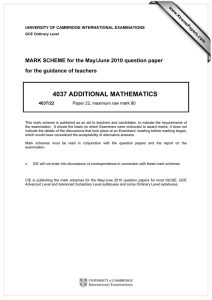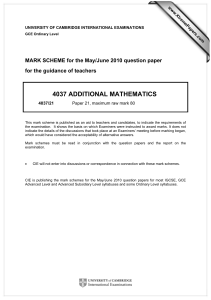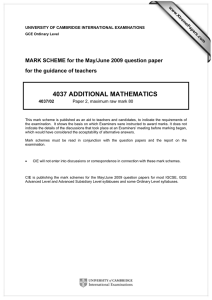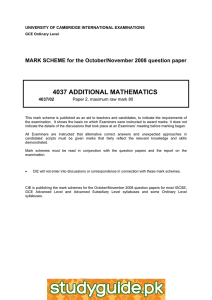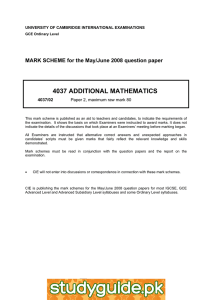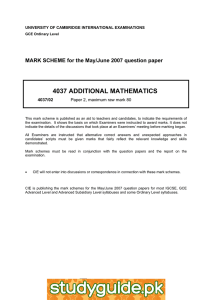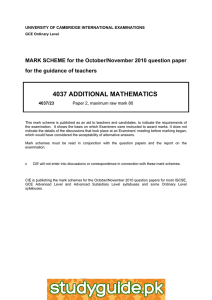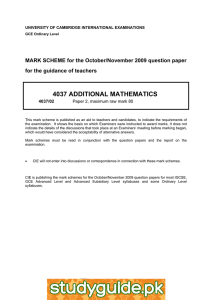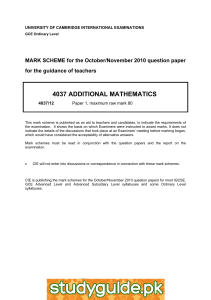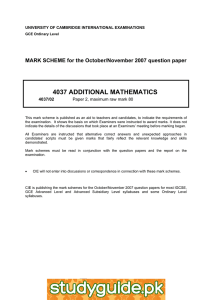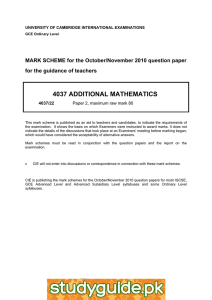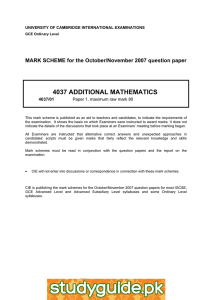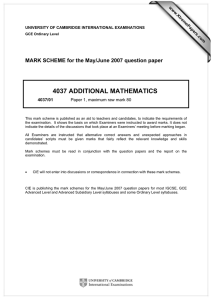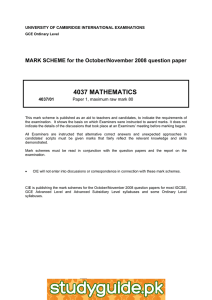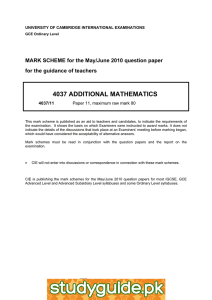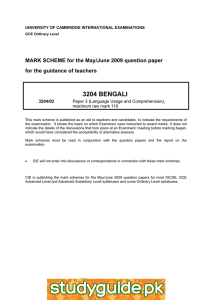4037 ADDITIONAL MATHEMATICS MARK SCHEME for the May/June 2010 question paper
advertisement
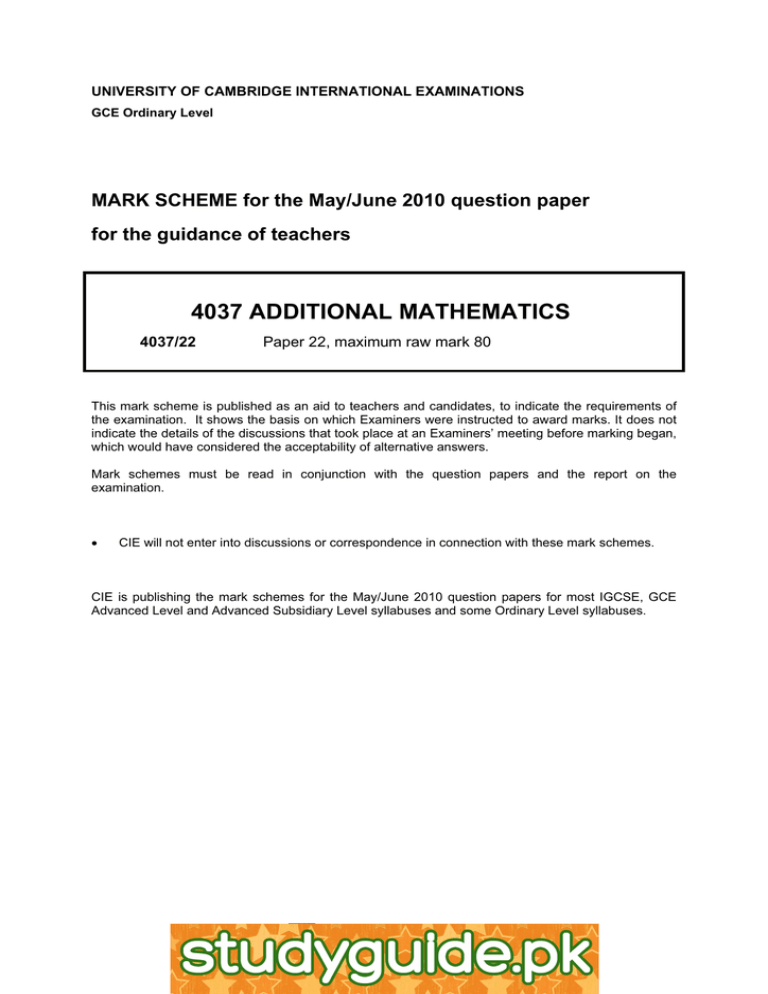
UNIVERSITY OF CAMBRIDGE INTERNATIONAL EXAMINATIONS GCE Ordinary Level MARK SCHEME for the May/June 2010 question paper for the guidance of teachers 4037 ADDITIONAL MATHEMATICS 4037/22 Paper 22, maximum raw mark 80 This mark scheme is published as an aid to teachers and candidates, to indicate the requirements of the examination. It shows the basis on which Examiners were instructed to award marks. It does not indicate the details of the discussions that took place at an Examiners’ meeting before marking began, which would have considered the acceptability of alternative answers. Mark schemes must be read in conjunction with the question papers and the report on the examination. • CIE will not enter into discussions or correspondence in connection with these mark schemes. CIE is publishing the mark schemes for the May/June 2010 question papers for most IGCSE, GCE Advanced Level and Advanced Subsidiary Level syllabuses and some Ordinary Level syllabuses. www.XtremePapers.net Page 2 Mark Scheme: Teachers’ version GCE O LEVEL – May/June 2010 Syllabus 4037 Paper 22 Mark Scheme Notes Marks are of the following three types: M Method mark, awarded for a valid method applied to the problem. Method marks are not lost for numerical errors, algebraic slips or errors in units. However, it is not usually sufficient for a candidate just to indicate an intention of using some method or just to quote a formula; the formula or idea must be applied to the specific problem in hand, e.g. by substituting the relevant quantities into the formula. Correct application of a formula without the formula being quoted obviously earns the M mark and in some cases an M mark can be implied from a correct answer. A Accuracy mark, awarded for a correct answer or intermediate step correctly obtained. Accuracy marks cannot be given unless the associated method mark is earned (or implied). B Accuracy mark for a correct result or statement independent of method marks. • When a part of a question has two or more "method" steps, the M marks are generally independent unless the scheme specifically says otherwise; and similarly when there are several B marks allocated. The notation DM or DB (or dep*) is used to indicate that a particular M or B mark is dependent on an earlier M or B (asterisked) mark in the scheme. When two or more steps are run together by the candidate, the earlier marks are implied and full credit is given. • The symbol √ implies that the A or B mark indicated is allowed for work correctly following on from previously incorrect results. Otherwise, A or B marks are given for correct work only. A and B marks are not given for fortuitously "correct" answers or results obtained from incorrect working. • Note: B2 or A2 means that the candidate can earn 2 or 0. B2, 1, 0 means that the candidate can earn anything from 0 to 2. © UCLES 2010 www.XtremePapers.net Page 3 Mark Scheme: Teachers’ version GCE O LEVEL – May/June 2010 Syllabus 4037 Paper 22 The following abbreviations may be used in a mark scheme or used on the scripts: AG Answer Given on the question paper (so extra checking is needed to ensure that the detailed working leading to the result is valid) BOD Benefit of Doubt (allowed when the validity of a solution may not be absolutely clear) CAO Correct Answer Only (emphasising that no "follow through" from a previous error is allowed) ISW Ignore Subsequent Working MR Misread PA Premature Approximation (resulting in basically correct work that is insufficiently accurate) SOS See Other Solution (the candidate makes a better attempt at the same question) Penalties MR -1 A penalty of MR -1 is deducted from A or B marks when the data of a question or part question are genuinely misread and the object and difficulty of the question remain unaltered. In this case all A and B marks then become "follow through √" marks. MR is not applied when the candidate misreads his own figures – this is regarded as an error in accuracy. OW -1,2 This is deducted from A or B marks when essential working is omitted. PA -1 This is deducted from A or B marks in the case of premature approximation. S -1 Occasionally used for persistent slackness – usually discussed at a meeting. EX -1 Applied to A or B marks when extra solutions are offered to a particular equation. Again, this is usually discussed at the meeting. © UCLES 2010 www.XtremePapers.net Page 4 1 2x + 2 (a) Mark Scheme: Teachers’ version GCE O LEVEL – May/June 2010 Syllabus 4037 5x2 1 + ( +c ) oe 2 x−2 A Paper 22 B1 + B1 + B1 [3] B C B1 3 (b) X '∪Y , ( X ∩ Y ' )' , X '∪( X ∩ Y ) , Y ∪ ( X ∪ Y )' , or Y ∪ ( X '∩Y ' ) oe B1 (c) 18 + 16 + 2 = 30 + x 6 M1 A1 dV 2 = 4 πr dr r=6 Uses B1 B1 dV d 4 3 1 = πr × dt dr 3 π M1 144 4 [4] A1 (i) Evidence of rationalising 16 2 or 1 7 3 or 16 7 6 8 6 oe 21 2 [4] M1 A1 ( ) 16 + 7 3 (ii) 2 2 M1 275 5 11 A1 A1 © UCLES 2010 www.XtremePapers.net [5] Page 5 5 6 Mark Scheme: Teachers’ version GCE O LEVEL – May/June 2010 Syllabus 4037 Search for first root or factor 1 x = –2 or or 3 or (x + 2) or (x – 3) or (2x – 1) 2 Attempt to factorise cubic (x + 2)(2x2 – 7x + 3) or (x – 3)(2x2 + 3x – 2) or (2x – 1)(x2 – x – 6) Solve 3 term quadratic 1 x = –2 and and 3 2 (i) A = xy A = 12x – 2x2 oe (ii) 8 M1 A1 M1 A1 M1 A1 dA = 12 − 4 x dx equate to 0 and solve x=3 B1√ M1 A1√ A1 B1√ (i) Idea of modulus correct Shape and position completely correct (0, 9) (–3, 0) indicated on graph M1 A1 A1 (ii) Straight line with +ve gradient and +ve y intercept, correct position B1 (iii) 3x + 9 = x + 6 ⇒ x = –1.5 Solve –(3x + 9) = (x + 6) or (3x + 9)2 = (x + 6) 2 x = –3.75 B1 M1 A1 (a) [6] M1 A1 (iii) A = 18 Completely correct method and maximum 7 Paper 22 (i) 1 – 21x + 189x2 – 945x3 [7] B3, 2, 1, 0 (ii) 2 × (189) and 5 × (–945) –4347 2 (b) Identifies relevant (x ) x [7] M1 A1√ 6 2 3 B1 Multiplies by 84 5376 M1 A1 © UCLES 2010 www.XtremePapers.net [8] Page 6 9 (i) Mark Scheme: Teachers’ version GCE O LEVEL – May/June 2010 B1 Uses quotient rule or product rule M1 1 − 2 ( x + 2 )( 4 x + 12 ) 2 −1 2 4 x + 12 or ( 4 x + 12 ) Express with common denominator of ( 4 x + 12 ) 2 ( x + 4) ( 4 x + 12 ) ( x + 2) 4 x + 12 3 × 2 −1 2 − 2 ( x + 2 )( 4 x + 12 ) n or k = 2 1 k C × ( x + 2) or log p p8 [8] M1 A1 log p X A1 log p Y 1.5 A1 (i) 2log2 3 = 3 or 25 × 3 2 z−5 = 3 or or log 2 32 + log 2 3 log 2 96 96 ( 4 M1 A1 (i) 2 log p X − log p Y (ii) A1 M1 4 x + 12 8 (b) 2 M1 9 oe 16 (ii) −3 A1 uses both limits correctly on 10 (a) Paper 22 d (4 x + 12) 12 = 1 (4 x + 12)−12 × 4 or d (4 x + 12)−12 = − 1 (4 x + 12)−3 2 × 4 dx 2 dx 2 ( 4 x + 12 ) (ii) Syllabus 4037 ) 512 = 2 9 9 2 or ( 512 ) = 4 9 2 or x = log 512 log 4 4 B1 M1 A1 B1 B1 11 (a) 0.85 B1 Subtract from π M1 2.29 A1 © UCLES 2010 www.XtremePapers.net [9] Page 7 (b) Mark Scheme: Teachers’ version GCE O LEVEL – May/June 2010 Syllabus 4037 4 cos y = 6sin y + sin y sin y B1 Uses sin 2 y = 1 − cos 2 y to reach quadratic in cos y M1 Solve 3 term quadratic cos y = 2 3 DM1 and cos y = − 1 A1 2 48.2 and 120 311.8 and 240 12E A1 A1√ (i) Rearranges to ax 2 + bx + c ( = 0 ) and uses b2 * 4ac A1 Solve 3 term quadratic M1 k = 4 and 12 A1 4 <k < 12 A1 2 or a = 2 , b = 5 , c = 15 or 3.75 2 4 (iii) minimum 15 x = −5 or 3.75 4 or −1.25 4 [9] M1 k2 – 16k + 48 * 0 5 15 (ii) 2 x + + 2 4 12O Paper 22 B1 + B1 + B1 B1√ B1√ [10] (i) (f) ≥ 1 B1 ( ) (ii) gf(3)=g(10) or gf ( x) = 2 x 2 + 1 − 5 15 M1 A1 (iii) g –1(15) = 10 B1 Finds fg(x) M1 ( 2 x − 5) + 1 or 4x 2 − 20 x + 26 2 Solves ( 2 x − 5 ) + 1 = 10 or 4x 2 − 20 x + 16 = 0 M1 1 and 4 A1 2 (iv) complete, labelled exponential curve complete logarithmic curve not cutting exponential curve © UCLES 2010 www.XtremePapers.net A1 B1 B1 [10]
